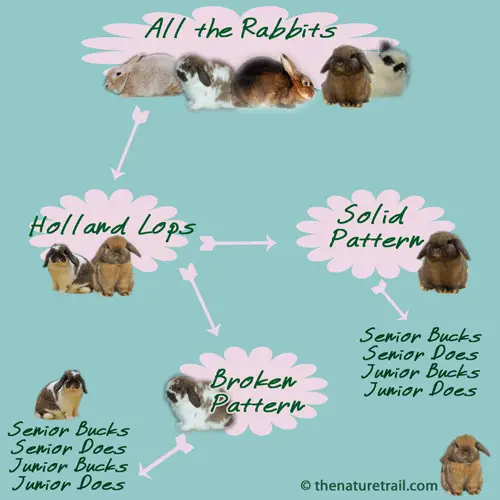Local rabbit shows can have as many as 1,000 to 2,000 rabbits entered. As per official show rules, all these rabbits must be sorted through by licensed judges, and a Best in Show selected from among them. Sound like a big task?
Well, like most major tasks, this one is sorted divided into many small jobs. It would be almost impossible to compare all 2,000 rabbits to each other, so we break them into small groups based on their breed, color, sex, and age. It goes like this:

As you see, all the rabbits are broken into separate breeds. There are currently 47 recognized or official breeds, with others floating around, such as Lionheads and Velveteen Lops. The breed we are using in this example is the Holland Lop.
Within the breed, rabbits are divided by color. Not all breeds allow the same colors, and not all breeds divide the colors the same way. Colors may be divided individually, or similar may be grouped together. You can find the allowed color divisions in the Standard of Perfection for your breed.
Holland Lops are divided into two color groups, “Broken Pattern” and “Solid Pattern.” At a show, solids are usually shown first. Solid rabbits can be any recognized color. Broken Patterned rabbits are spotted; any color on a white backdrop.
Within each color there are four classes, based on age and sex. The classes are Senior Buck, Senior Doe, Junior Buck, and Junior Doe, shown in that order. Male rabbits are called bucks and females are called does. Seniors are rabbits over six months of age, and juniors are under six months of age.
The Holland Lop classes are judged in this order. You need to be familiar with this order so that you will know when to bring your rabbits to the table. Judges are not required for all the entries to arrive before they place the class, so be careful not to miss it. Most classes will not be announced over the loud speaker!
1. Solid Senior Buck
2. Solid Senior Doe
3. Solid Junior Buck
4. Solid Junior Doe
****Now the Best Solid is selected from the four class winners. This is known as the Best of Variety or BOV. The Best Opposite Sex of Variety is also selected. If the BOV is a buck, the BOSV is one of the two class-winning does. After the BOV and BOSV are chosen, all the rest of the solids are done showing. The BOV and BOSV remain to compete for Best of Breed****
Now the same thing happens with the brokens:
1. Broken Senior Buck
2. Broken Senior Doe
3. Broken Junior Buck
4. Broken Junior Doe
**** Broken BOV and BOSV****
Now only four rabbits remain on the table: the two best brokens and the two best solids. From these, the Best of Breed and Best Opposite Sex of Breed are selected.
The Best of Breed waits for the Best in Show judging. All the other Holland Lops are done for the day.
Now as we mentioned, not all breeds use these exact colors, broken and solid. All the lop breeds do – American Fuzzy, Holland, French, Mini, and English — but the other breeds use a variety of color combinations. Our page about writing for a judge can help you learn how your breed divides the colors.
Check out the next article to learn what happens in the judging process!
![]()
